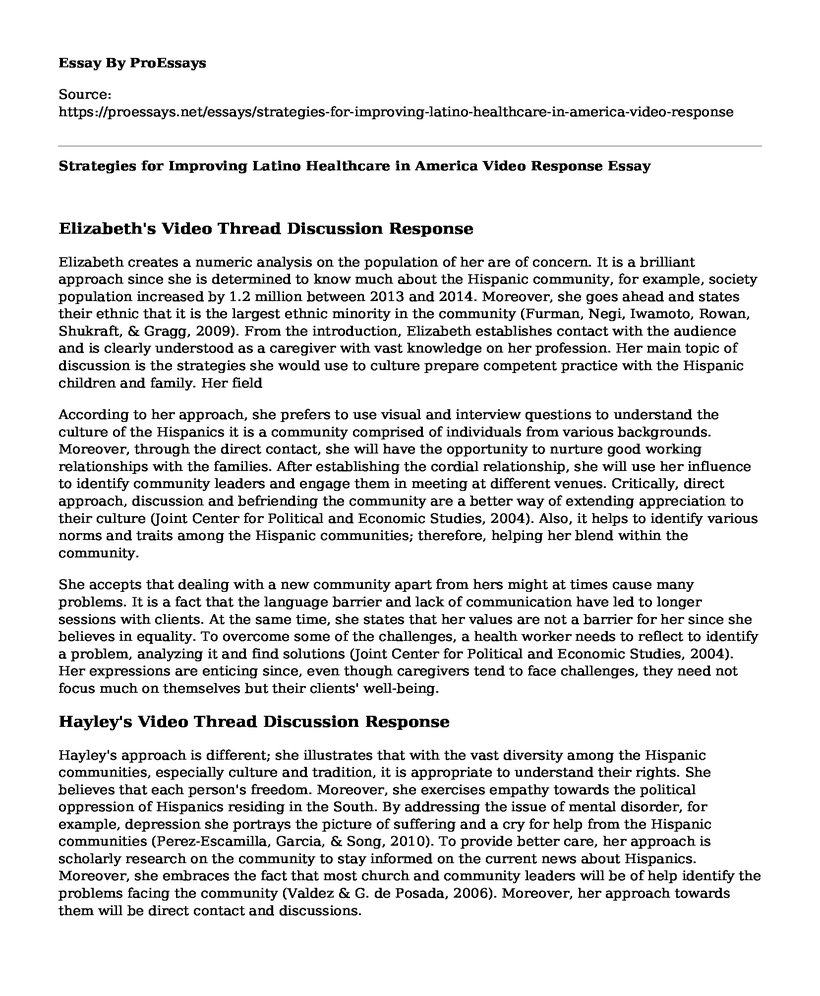Elizabeth's Video Thread Discussion Response
Elizabeth creates a numeric analysis on the population of her are of concern. It is a brilliant approach since she is determined to know much about the Hispanic community, for example, society population increased by 1.2 million between 2013 and 2014. Moreover, she goes ahead and states their ethnic that it is the largest ethnic minority in the community (Furman, Negi, Iwamoto, Rowan, Shukraft, & Gragg, 2009). From the introduction, Elizabeth establishes contact with the audience and is clearly understood as a caregiver with vast knowledge on her profession. Her main topic of discussion is the strategies she would use to culture prepare competent practice with the Hispanic children and family. Her field
According to her approach, she prefers to use visual and interview questions to understand the culture of the Hispanics it is a community comprised of individuals from various backgrounds. Moreover, through the direct contact, she will have the opportunity to nurture good working relationships with the families. After establishing the cordial relationship, she will use her influence to identify community leaders and engage them in meeting at different venues. Critically, direct approach, discussion and befriending the community are a better way of extending appreciation to their culture (Joint Center for Political and Economic Studies, 2004). Also, it helps to identify various norms and traits among the Hispanic communities; therefore, helping her blend within the community.
She accepts that dealing with a new community apart from hers might at times cause many problems. It is a fact that the language barrier and lack of communication have led to longer sessions with clients. At the same time, she states that her values are not a barrier for her since she believes in equality. To overcome some of the challenges, a health worker needs to reflect to identify a problem, analyzing it and find solutions (Joint Center for Political and Economic Studies, 2004). Her expressions are enticing since, even though caregivers tend to face challenges, they need not focus much on themselves but their clients' well-being.
Hayley's Video Thread Discussion Response
Hayley's approach is different; she illustrates that with the vast diversity among the Hispanic communities, especially culture and tradition, it is appropriate to understand their rights. She believes that each person's freedom. Moreover, she exercises empathy towards the political oppression of Hispanics residing in the South. By addressing the issue of mental disorder, for example, depression she portrays the picture of suffering and a cry for help from the Hispanic communities (Perez-Escamilla, Garcia, & Song, 2010). To provide better care, her approach is scholarly research on the community to stay informed on the current news about Hispanics. Moreover, she embraces the fact that most church and community leaders will be of help identify the problems facing the community (Valdez & G. de Posada, 2006). Moreover, her approach towards them will be direct contact and discussions.
Harley states the question of How can Hispanic communities receive healthcare since their access to the medical facilities is less than other communities? According to her opinion, she suggests that there need to be more health workers in the community to provide medical services. It is true since Hispanic communities are classified under the middle-class and low-income earners (Perez-Escamilla, Garcia, & Song, 2010). Therefore, they find it difficult to get medical attention. Moreover, she believes in networking with the local community centres, churches, and other health workers to provide better care.
Her values and beliefs are not a barrier towards assisting the community. To overcome the challenge get too involved health workers to need to be universal; thus, their values should not get in the way their profession (Valdez & G. de Posada, 2006). Harley provides an outstanding presentation with the aim and morals of reinforcing the unity within the Hispanic communities. Also, calls for aid and communication with other health workers as a means of identifying the problems within the community.
References
Furman, R., Negi, N., Iwamoto, D., Rowan, D., Shukraft, A., & Gragg, J. (2009). Social Work Practice with Latinos: Key Issues for Social Workers. Social Work, 54(2), 167-174.
Joint Center for Political and Economic Studies. (2004). Community-Based Strategies for Improving Latino Health. Joint Center for Political and Economic Studies and Policy Link.
Perez-Escamilla, R., Garcia, J., & Song, D. (2010). Health Care Access among Hispanic Immigrants: ALGUIEN ESTA ESCUCHANDO? [IS ANYBODY LISTENING?]. Napa Bull, 34(1), 47-67.
Valdez, J., & G. de Posada, R. (2006). Strategies for Improving Latino Healthcare in America. Report of The Latino Healthcare Taskforce.
Cite this page
Strategies for Improving Latino Healthcare in America Video Response. (2022, Jul 01). Retrieved from https://proessays.net/essays/strategies-for-improving-latino-healthcare-in-america-video-response
If you are the original author of this essay and no longer wish to have it published on the ProEssays website, please click below to request its removal:
- Adequate Staffing vs. Inadequate Staffing in Nursing - Term Paper
- Clinical Reflection Paper on Nursing
- Overcoming Hypertension: Ranking As Second-Leading Global Mortality Cause - Essay Sample
- Essay Example on Breastfeeding: Essential Nutrients, Jaw Exercise, and Health Benefits
- Spanish Flu & COVID-19: Respiratory Diseases & Their Comparisons - Essay Sample
- Joint Commission Accreditation: Strengthening Patient Safety & Organizational Growth - Essay Sample
- Paper Example on 4 Types of Evidence in Ramsey Case: Physical, Doc., Expert, DNA







